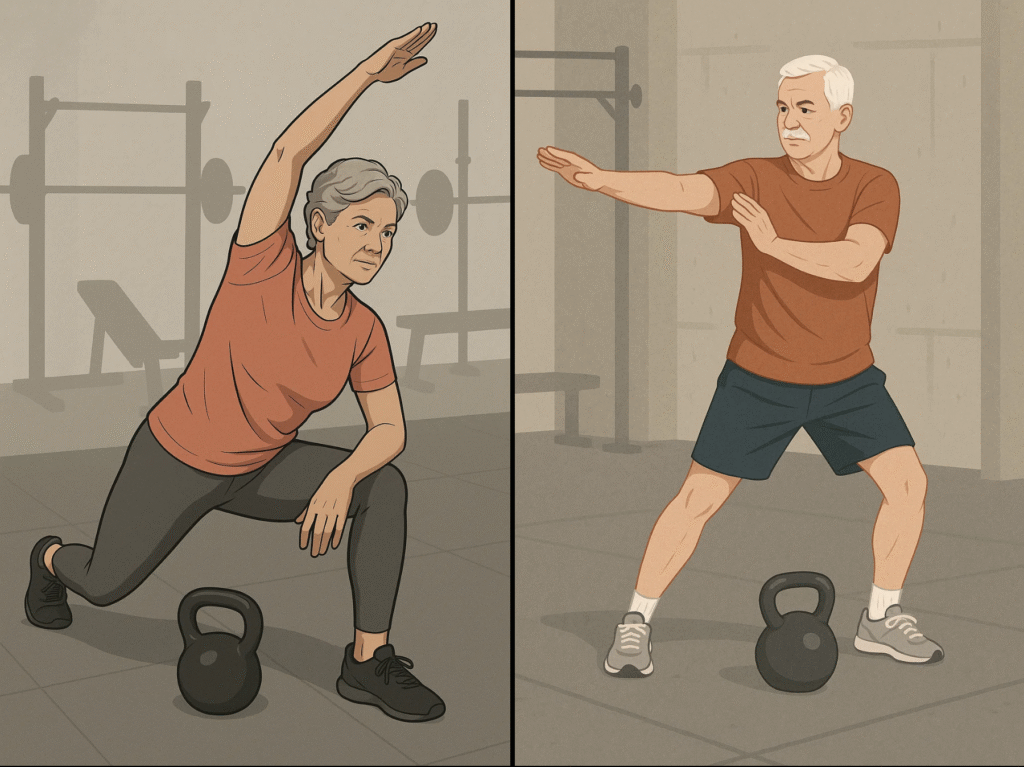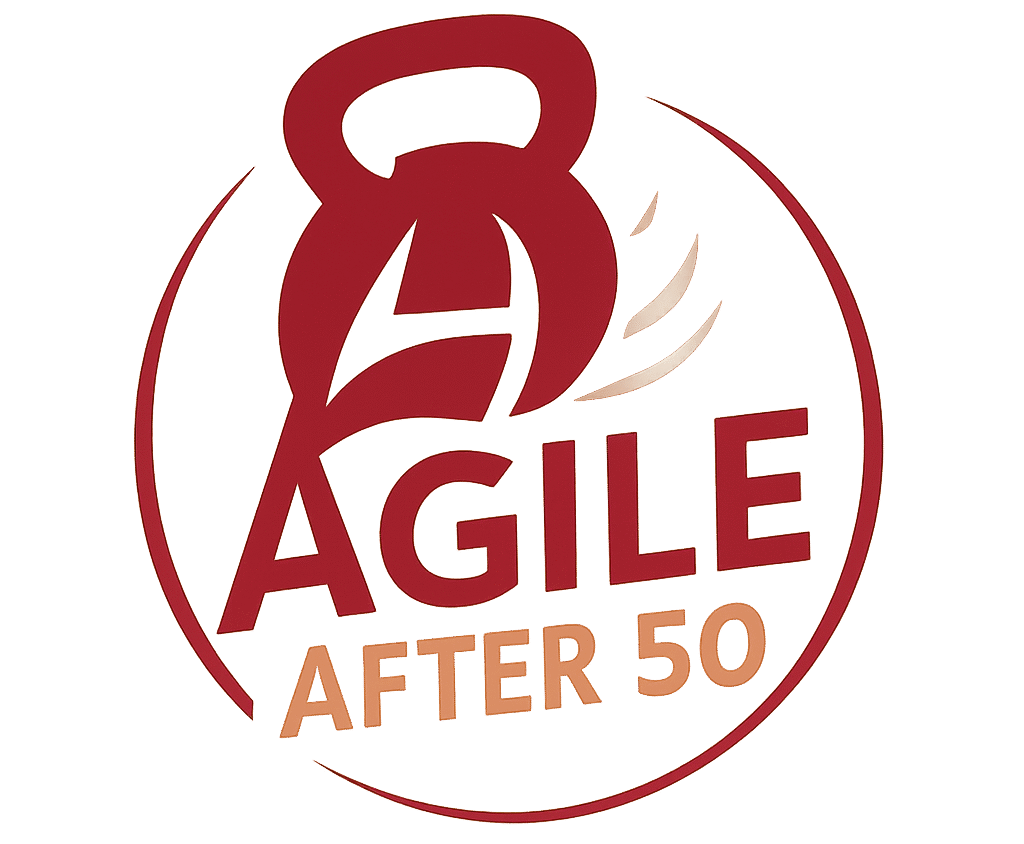One of the biggest fears for people starting or restarting strength training in their 50s, 60s, or beyond is injury. And rightly so — at this stage of life, our bodies don’t bounce back quite as quickly as they used to. A strained muscle, an aching back, or an injured shoulder can set you back for weeks, and it’s easy to lose momentum when that happens.
But here’s the good news: with the right approach, strength training over 50 can be incredibly safe, effective, and life-changing. In fact, the benefits far outweigh the risks — improved bone density, stronger muscles, better balance, and more energy for daily life. The key is learning how to train smart.
In this article, we’ll explore the 10 most important things you need to know to avoid injury in strength workouts over 50. Whether you’re picking up a kettlebell for the first time or dusting off your resistance bands after years of inactivity, these principles will help you stay strong, mobile, and injury-free.

1. Start with a Solid Warm-Up
As we age, our muscles, joints, and connective tissues require more preparation before engaging in resistance training. Jumping straight into lifting cold can be a recipe for strains.
Spend 5–10 minutes warming up with light cardio, such as walking, cycling, or marching in place. Follow this with dynamic movements such as arm circles, hip openers, or torso twists. These moves increase blood flow, lubricate the joints, and prepare your nervous system for the work ahead.
Think of your warm-up as priming the engine. The older the engine, the more it benefits from a little extra time before running at full speed.
2. Prioritise Proper Technique
Technique trumps everything else, especially weight. Many injuries over 50 come not from lifting heavy, but from lifting poorly.
Keep these cues in mind:
- Maintain a neutral spine (no rounding or over-arching).
- Control each movement — avoid jerking or swinging weights.
- Focus on quality reps over quantity.
If you’re unsure about your form, record yourself on video or work with a trainer for a session or two. An hour spent learning correct technique can save you months of recovery from an avoidable injury.
3. Progress Slowly and Gradually
Progressive overload is how we get stronger — but the keyword is progressive. After 50, tissues like tendons and ligaments adapt more slowly than muscles.
Increase intensity in small, measured steps:
- Add just 1–2 kg to a kettlebell rather than jumping up too quickly.
- Add one extra set before drastically increasing reps.
- Give yourself several weeks to adapt before the next progression.
Patience pays off. Small, steady gains compound into big improvements without the setbacks of injury.
4. Use Appropriate Equipment
The right tools can make your workouts safer and more effective. For those over 50, joint-friendly options such as resistance bands, kettlebells, and bodyweight training are ideal. These allow for natural movement patterns and build both strength and stability.
Avoid equipment that forces you into unnatural positions or strains your joints. For example, some gym machines lock you into rigid paths that may not suit your body mechanics. Free weights, bands, and functional tools give your body freedom to move naturally.
A good rule of thumb: if it feels awkward or painful on the joints, swap it for a different variation.
5. Listen to Your Body
This point might sound simple, but it’s one of the hardest for people to follow — especially if you’re motivated to make progress quickly.
Learn to distinguish between:
- Muscle fatigue (a burning sensation, tiredness, or heaviness — this is good).
- Joint pain or sharp discomfort (this is a warning sign).
Never push through sharp pain. Stop, adjust, and modify. Often, a small tweak in movement or switching to a lighter load can resolve the issue.
Remember: soreness fades, but injuries linger. Listening to your body keeps you training consistently.
6. Prioritise Mobility and Flexibility
Strength without mobility is like having a powerful car with stiff steering. It increases your risk of injury because the body can’t move through safe ranges of motion.
Incorporate mobility work into your weekly routine. Simple practices include:
- Dynamic stretches before workouts (leg swings, shoulder circles).
- Static stretches after workouts (hamstrings, chest, calves).
- Occasional yoga or mobility flows to keep joints supple.
Pay special attention to the hips, shoulders, and spine — the areas most prone to stiffness after 50. The more mobile you are, the less likely you’ll strain something during strength training.
7. Mind Recovery and Rest
One of the biggest changes after 50 is recovery time. Muscles, tendons, and connective tissue all take longer to repair and strengthen. That’s not a limitation — it just means you need to schedule rest wisely.
Tips for better recovery:
- Allow 48 hours between heavy strength sessions targeting the same muscle group.
- Sleep at least 7–8 hours — this is when most repair happens.
- Stay hydrated to support joint health.
- Nourish your body with protein and whole foods to fuel muscle recovery.
Rest is not weakness; it’s where the growth happens. Overtraining is one of the fastest routes to injury.
8. Strengthen Core and Stabilisers
Many injuries come from a weak core — not just the abs, but the entire trunk and stabilising muscles that support the spine and pelvis.
Incorporate exercises such as:
- Planks (front and side).
- Bird-dogs (opposite arm and leg extensions).
- Glute bridges for hip stability.
A strong core doesn’t just protect the back. It also improves posture, reduces fall risk, and gives you more power in every lift. Think of your core as the foundation — if it’s weak, the house above it wobbles.
9. Don’t Skip Balance Work
Falls are one of the most common causes of injury as we age. The good news? Balance is a skill you can train, and strength training is the perfect opportunity to include it.
Try these balance builders:
- Single-leg exercises (step-ups, lunges, single-leg deadlifts).
- Heel-to-toe walking to train gait stability.
- Standing on one leg while performing upper-body movements.
By challenging your balance during training, you not only prevent falls in everyday life but also build resilience against unexpected stumbles.
10. Check Medical and Lifestyle Factors
Finally, don’t ignore the bigger picture. Past injuries, arthritis, osteoporosis, or certain medications can influence how you train safely.
Before starting (or restarting) a strength program after 50, it’s wise to:
- Consult your GP, especially if you have health conditions.
- Share your exercise plans and get advice on any limitations.
- Adapt your training to fit your current health, not just your goals.
You’re not competing with anyone else — your workout should serve you. By tailoring it to your unique body, you’ll reduce injury risk and enjoy steady progress.
Final Thoughts: Train for the Long Game
Strength training after 50 is one of the best investments you can make in your health, independence, and quality of life. The benefits go far beyond muscle — they extend to bone strength, joint protection, energy, and confidence in everyday movement.
Avoiding injury doesn’t mean avoiding challenge. It means training smart: warming up properly, focusing on technique, progressing gradually, and giving your body the respect it deserves.
The real goal isn’t to see how much weight you can lift today — it’s to stay strong, agile, and injury-free so you can keep lifting, walking, hiking, playing with grandkids, and enjoying life for decades to come.
So the next time you step into a workout, remember: you’re not just building strength. You’re building resilience, independence, and the ability to live fully — all without the setbacks of avoidable injuries.
Related Reading on Agile Over 50
If you found this guide helpful, you might also enjoy these articles:
